Tony
Morrison writes in 2014… 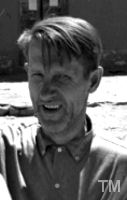 If
the references had not been so good I would have thought I was being sent on a
wild goose chase. Piotr Zubrzycki a Polish geologist working for the Bolivian
National Mining Corporation was telling me an amazing story 'There's an old
mining town down there and it's full of history - San Antonio is a ghost town
and empty because it's so cold'. Piotr had graduated from Edinburgh University
and settled in La Paz with his family. If
the references had not been so good I would have thought I was being sent on a
wild goose chase. Piotr Zubrzycki a Polish geologist working for the Bolivian
National Mining Corporation was telling me an amazing story 'There's an old
mining town down there and it's full of history - San Antonio is a ghost town
and empty because it's so cold'. Piotr had graduated from Edinburgh University
and settled in La Paz with his family.
It
was 1963 and I was in Bolivia looking for themes for television films. Back in
London the BBC editors had given me plenty of freedom but I could hear their thoughts....'a
400 year old, tumbledown ghost town? Almost 600kms away and totally isolated in
an arid wilderness at an altitude of about 4,600m?' The
production cash-till was ringing. How could I even suggest it? Piotr said there
was a rough road for the first 250kms and after that, just tracks. 'With a
Land Rover you'll take four or five days to get there… and you will find
a near perfect Spanish Colonial church, gilded inside with a painted roof - also
....there are many old religious paintings.' San
Antonio de Lipez 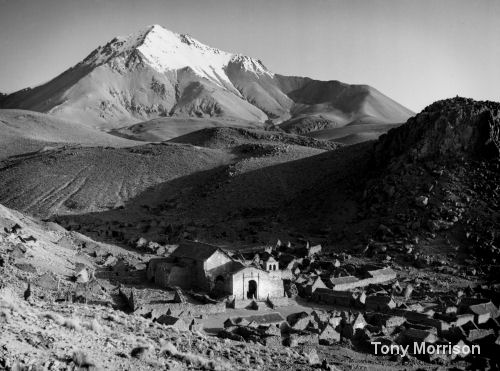 I
had met Marion a few months earlier and we had become engaged - not really such
a spur of the moment decision I can assure you. We just wanted the same kind of
life so we said OK let's go for it and with three companions set out for San Antonio
de Lipes. I
had met Marion a few months earlier and we had become engaged - not really such
a spur of the moment decision I can assure you. We just wanted the same kind of
life so we said OK let's go for it and with three companions set out for San Antonio
de Lipes.
I'll mention here that the spelling is sometimes with a 'z' though old documents
use the Spanish form 'Lipes'. True to Piotr's estimate the old town came in sight
late on the fifth day. The track led over a shoulder to a view of a snowcapped
mountain El Nuevo Mundo - The New World and San Antonio was nestled in
a fold. The
ruined town is about 43kms away from the border of Argentina though when it was
built in the seventeenth century such national boundaries did not exist. This
area was part of Alto Peru of the Spanish Vice-Royalty of Peru seated in Lima
on the Pacific coast. In
1776 the control of the region was passed to the Audiencia de Charcas under the
Spanish Vice-Royalty of the Rio de La Plata seated in Buenos Aires. The
politics of the changes are for historians to discuss but in its heyday the wealth
from the mines of this region went by mules trains to the Pacific coast. And that
is for another story.... The
New World nountain is sometimes known as El Cerro Lipes but most genearlly
as the El Nuevo Mundo - with a height of 5898m and GPS of 21 54 53 S -
66 53 04 W. For our journey we did not have GPS and worked by an old Bolivian
map and for the last stage by local information. We were on the southern eastern
edge of the Salar or 'salt-pan' of Uyuni about 160kms away from the mountain and
a local pointed to a snowcap just topping the horizon and said 'that's El Nuevo
Mundo'. Padre
Alonso Barba and his Arte de los Metales published in Madrid 1640  And
true to Piotr's description the old town lay in ruins. The seventeeth century
miners were long gone. Piotr had found the place because in his search for viable
mineral resources in Bolivia he used the records of early Spanish miners and priests
such as the book written by Padre Alonso Barba in 1640 who knew the region well
- the provinces of Lipes were bywords for silver and hence wealth in the days
when Potosi, the famed Silver City, was a rising star in the Andes. Charles V
of Spain bestowed on Potosi the unforgettable motto 'I am rich Potosi, Treasure
of the world and the envy of Kings'. And
true to Piotr's description the old town lay in ruins. The seventeeth century
miners were long gone. Piotr had found the place because in his search for viable
mineral resources in Bolivia he used the records of early Spanish miners and priests
such as the book written by Padre Alonso Barba in 1640 who knew the region well
- the provinces of Lipes were bywords for silver and hence wealth in the days
when Potosi, the famed Silver City, was a rising star in the Andes. Charles V
of Spain bestowed on Potosi the unforgettable motto 'I am rich Potosi, Treasure
of the world and the envy of Kings'.
Alvaro
Alonso Barba was born 1569 in Spain, probably in the village of Lepe, near Huelva
in Andalucia and chose the Church for his life's work. Padre Barba journeyed to
Peru and his first curacy was in the village of Tiahuanacu - also known today
as Tiwanaku near Lake Titicaca. From there he was sent to the distant, and by
then flourishing provinces around Potosi. He stayed some years in to San Cristóbal
de Lipes, a small village but an important mining centre a few kilometers south
of the Salar of Uyuni. And from there he went to the Parish of San Bernardo in
Potosi. It
was in San Cristóbal that Padre Barba began his writing and experiments
concerning the mining and processes for the extraction of silver from minerals.
Padre Barba spent almost 50 years of his life studying silver production. No wonder
that Piotr relied so heavily on the priest - he knew so much. Our
copy of the book has a facsimile cover and was published in Potosi in 1967. The
wilderness of the southern Bolivian Andes, the old mines shown to us by Piotr
Zubrzycki and the story of Padre Barba riveted me for several years afterwards
and still does….. but all that is for later. This is about a painting of
the biblical Last Supper we saw in the old town of San Antonio de Lipes all those
years ago. We
arrived in San Antonio 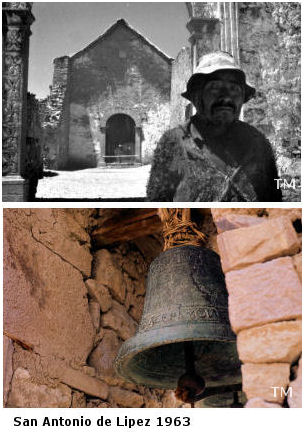 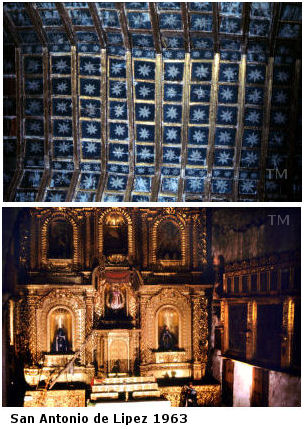 The
old town was not totally empty as one elderly man and his family lived there to
care for the church. Apparently a priest called by every year for a small festival
when a handful of llama herders gathered. The
old town was not totally empty as one elderly man and his family lived there to
care for the church. Apparently a priest called by every year for a small festival
when a handful of llama herders gathered.
The
man opened the door using a massive key and showed us around.
And just as Piotr said it was heavily gilded. The wooden ceiling was gilded and
painted in dark blue with stars, and paintings of varying sizes by Spanish colonial
artists were hanging dust-covered on the walls.
It would have been a conservator's worst nightmare had it not been for the very
low humidity and the cold - it must have been sub-zero for much of the year. Two
huge brass bells with inscriptions and dates were hanging by bunches of leather
straps from bars in the stone-built tower. The
ancient building and the contents were a frozen time-capsule. My film camera rolled
and we had a fascinating end to a story. Our
old photographs I
took some photos - But remember. In 1963 my colour film for interiors was Kodak
Ektachrome transparency film and my electronic flash was simple and small. My
modern standards it was primitive ....but it was small as weight for travelling
was all important in those early days. The
35mm film pictures were on Nikon F cameras and they came off reasonably well considering
the conditions, but my larger size on Ektachrome of 6 x 6cms and taken on a Twin
Lens Reflex were not so good as the flash synchronising was slightly 'off'. At
the time I assumed the results were useless and the cut transparencies ended up
in a brown envelope labelled 'Old Spanish mining Lipez' at the bottom a drawer
labeled 'Bolivia'. And there they stayed for 50 years. But
technology has moved on and those old dark, almost black images have been tweeked
into life. Marion scanned them thinking seriously that they should be in one of
our 'special Collections' and abracadaba one of the negatives revealed
a painting of the biblical Last Supper. And the colour is fair considering the
age of the painting - perhaps 300 years, plus the 51 years of the film - Ektachrome
transparencies have a tendency to fade or change colour often to reds or purple.
The detail on the larger film is amazingly sharp giving some extraordinary detail. The
Last Supper in San Antonio de Lipes The
biblical Last Supper refers to the final meal of Christ before His Apostles on
the night before the Crucifixion. The gathering and meal are given different scholarly
intepretations but in the Andes of the seventeeth century the religion was Catholic
overlaying a rich indigenous reverence of the world of the mountain spirits, the
sky and the earth. Academically it is 'syncretism'. In
Catholic terms the painting appears to depict the institution of the Eucharest
with all the Apostles and Christ seated at the moment of the consecration of the
bread and the wine. If
the Unknown Artist was from a part-indigenous family or even purely indigenous
the symbolism is a valuable record of life at the time. The Apostles may have
been painted by copying but most likely they bear some resemblance in facial style
to the wealthy Spaniards or their family descendants in Potosi. And
the table settings and food are a special clue suggesting an indigenous painter,
most likely schooled under the Potosi master Melchor Peréz Holguin 1660-1732.
Holguin was born in Cochabamba in the eastern Andean valleys of parents from Potosi.
The years 1680 -1750 was a Golden Age for the Potosi painters and San Antonio,
needing paintings was in its prime. 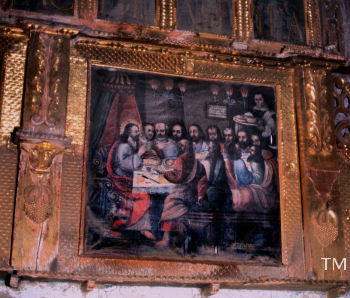 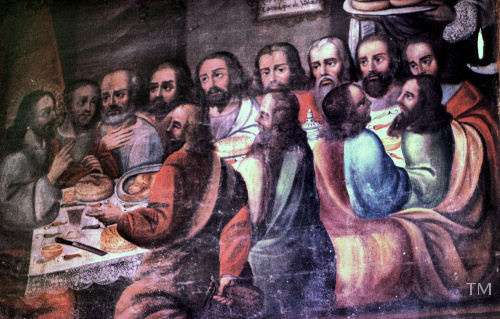
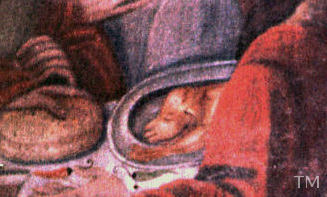 The
San Antonio supper seen above and on the left is frugal and very typical of the
chill Bolivian Andes. On the silver plate the meat is from a small animal probably
the local cui, the guinea pig [Cavia. sp] The
San Antonio supper seen above and on the left is frugal and very typical of the
chill Bolivian Andes. On the silver plate the meat is from a small animal probably
the local cui, the guinea pig [Cavia. sp]
There
is substantial bread, some country style cheese much as made today and perhaps
a glass of chicha. The glass beside the right hand of Christ [above] is
filled with a cloudy liquid resembling the traditional fermented maize flour drink
of the Andes. But
most noticeable are the ajis or peppers, red and green, in each place setting.
Even in 1960s and 70s when we were in those cold places a traditional meal in
the Bolivian highland villages always included an aji or other local chile.
The aji was also very symbolic and used in preparing special food for offerings.
There
is a red aji close to the bread in the picture on the left.. The
Last Supper in Cuzco, Peru 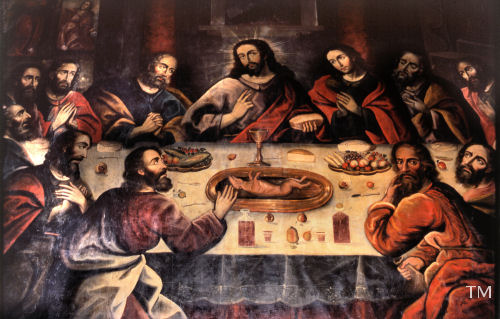 We
have another 'Last Supper' photograph in our Andean collections - the now famous
painting by Marcos Zapata a Spanish-taught Quechua artist. The painting is in
the cathedral in Cusco completed in 1654 and built on one of the greatest Inca
shrines. Today
Cusco is the much visited Inca centre of Peru. We
have another 'Last Supper' photograph in our Andean collections - the now famous
painting by Marcos Zapata a Spanish-taught Quechua artist. The painting is in
the cathedral in Cusco completed in 1654 and built on one of the greatest Inca
shrines. Today
Cusco is the much visited Inca centre of Peru.
The
mind grabbing point of the Zapata painting is the food on the table - it is roast
guinea pig or cui, a native animal (Cavea sp) of the Andes. In
the painting we saw in San Antonio 1963 the dish looks very similar. But apart
from the cui, the silver plates and a lacy tablecloth with a decorated
edge, the rest of the setting has some fascinating differences. Picture
on Kodachrome 35mm film using a timed exposure.
The colours in Kodachrome are far more stable that those in Ektachrome 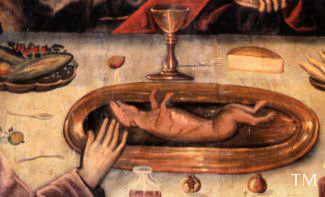 In
the Zapata picture the food includes simple bread and cheese. These are accompanied
by bananas, grapes and what appears to be maracuya or passion fruit. Cusco
is close to the warm sub-tropical valleys of La Convención province below
Machu Picchu. In
the Zapata picture the food includes simple bread and cheese. These are accompanied
by bananas, grapes and what appears to be maracuya or passion fruit. Cusco
is close to the warm sub-tropical valleys of La Convención province below
Machu Picchu.
Also, in the Zapata painting they appear to be drinking wine - the flask or decanter
is narrow-necked and the glasses are filled with a clear liquid. An hacienda
near Cusco was the earliest of Peru's wine producers. The
collapse of San Antonio church The
last time I was in San Antonio was in 1971. The church and its collection had
not changed. It was a time-capsule and still off the beaten track as mass tourism
had not arrived. Then in the 1990s, a traveller who walked much of the last 100
kms because the track had deteriorated and was covered with volcanic sand, reported
that the church's ichu grass roof had collapsed - the golden reredos had
gone and the ruins were empty. The family guardians had moved on. The collapse
was inevitable given San Antonio's isolation, and sad neglect. Potosi
- a chapel in the Santa Teresa Convent 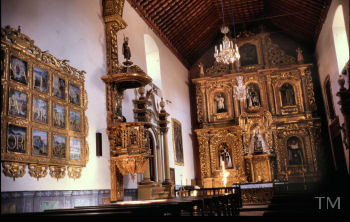 The
artefacts had been taken to Potosi to be kept in a special chapel of the Santa
Teresa convent, founded in 1616 by the wealthy 'doña Ana Orquendo and her
husband don Lorenzo Nariondo de Orquendo at a cost of 1,00,000 pesos'. Money flowed
like water in seventeenth century Potosi. The
artefacts had been taken to Potosi to be kept in a special chapel of the Santa
Teresa convent, founded in 1616 by the wealthy 'doña Ana Orquendo and her
husband don Lorenzo Nariondo de Orquendo at a cost of 1,00,000 pesos'. Money flowed
like water in seventeenth century Potosi.
I
made a special visit in 1998 and sure enough the reredos was there with some paintings
but no sign of the Last Supper. All I could hope was that Bolivian conservators
and not international art traders were hard at work on that painting, and others
from the old church. Photo
on Agfachrome 35mm film My
film-making partner was Mark Howell and we had formed Nonesuch Expeditions almost
a year earlier. Mark wrote an account of the mini expedition in Journey Through
a Forgotten Empire published 1964. With
special thanks to the Instituto Cinematagráfico Boliviano, Julia Elena
Fortún, Ministerio de Educación, La Paz and Alfredo La Placa. And
to our companions Allan Reditt and Jackie Chester who were with us in 1963, cramped
together in the back of the Land Rover, and who are still shaking off the dust. Peter
Francis One evening in 1965 I gave a talk to the Imperial College Exploration
Board - London, and it fired the imagination of a group of geology students who
made a journey to San Antonio in the following year. One of the team was Peter
Francis who went on to an academic research career, eventually becoming Professor
of Volcanology at the Open University. The full report is on-line
- The Minas de Lipez [Bolivia] Expedition 1966.
I must mention here that the students recorded - ...One
of the biggest of these mining towns, San Antonio de Lipez has remained almost
exactly as it was when the Spanish left; the cathedral is still unbelieveably
intact, and a profusion of elaborate carving, gilding, and silver work around
the altar-screen testify to the former wealth of the area..... https://workspace.imperial.ac.uk/expeditions/Public/MinasDeLipezBolivia1966.pdf Peter
and his team sent a report to The Times, London with the dateline From a Special
Correspondent - San Antonio de Lipez , Bolivia and the story was published
on September 9th 1966.
SEEKING THE SECRETS OF SPANISH SILVER. Peter
Francis died in 1999
|